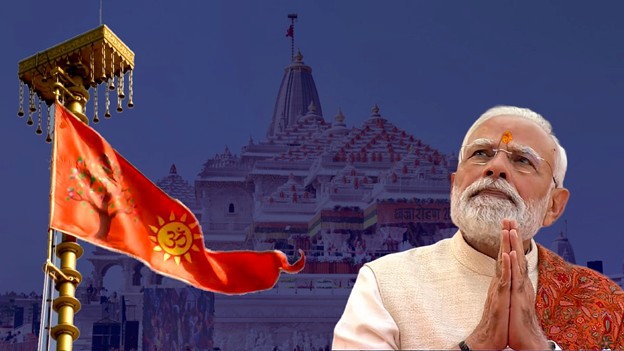The flag hoisting marked the formal completion of the Ram Temple construction; PM urges citizens to “awaken the Ram within” to realize India’s ‘super power’ dream
AYODHYA (Uttar Pradesh): Prime Minister Narendra Modi on Tuesday said India and the world are immersed in Ram, as he described the installation of the Dharma Dhwaja atop the newly-constructed Ram Temple as a moment that heals “wounds of centuries” and marks the fulfilment of a civilisational resolve kept alive for 500 years.
Modi along with RSS Sarsanghchalak Mohan Bhagwat ceremonially hoisted the saffron flag on the Shikhar of the Ram Temple, which marked the ceremonial completion of its construction.
Addressing the gathering at the ‘Dwajarohan’ ceremony, the PM said, “The moment symbolised a cultural resurgence for the nation. There is extraordinary satisfaction in the heart of every Ram devotee. There is boundless gratitude. There is unfathomable supernatural bliss. The wounds of centuries are being healed. Centuries-old wounds are healing, centuries-long pain is finding closure, as the resolve that burned for 500 years finally reached its fulfilment.”
“Today, the energy of Lord Ram is established at the ‘shikhar’ of the Grand Ram Temple in the form of this Dharma Dhwaja,” he said. Terming the flag-hoisting “a unique and divine moment”, the PM said the sacred flag atop the Ram temple would stand as a testimony to the fact that “truth ultimately triumphs over falsehood”.
Elaborating on the symbolism of the flag, he noted that it reflects the rebirth of an ancient civilisation and embodies the ideals of Ram Rajya. “This Dharma Dhwaja is not just a flag. It is the flag of the rejuvenation of Indian civilisation. The Saffron colour, Suryavansh’s signia, the ‘Om’ word, and the Kovidara tree impersonate Ram Rajya’s glory. This flag is a resolution, a success, a story of struggle to creation, a physical form of the struggle of 100s of years. For the coming thousands of centuries, this flag will proclaim Lord Ram’s values. Truth is Dharma. There should be no discrimination or pain, and there is peace and happiness. There should be no poverty, and no one is helpless,” he added.
In Ayodhya, Modi outlines roadmap for Viksit Bharat @ 2047
‘India must draw strength from its civilisational roots and break free from the British-era legacy of slave mentality to become a super power’
Ayodhya (Uttar Pradesh): Prime Minister Narendra Modi described the raising of the Dharma Dhwaja (flag) atop the Ram Janmabhoomi Temple as a “historic” moment, saying India must draw strength from its civilisational roots while shedding its “slave mentality” in order to become a super power by 2047.
Addressing devotees, the PM invoked the ideals associated with Lord Ram to highlight his vision of a confident, future-oriented India. “Ram is not a person, He is a value. If we want to make India developed by 2047, we have to awaken Ram within ourselves. What day can be better than today for this resolution?” he asked.
Reiterating that Lord Ram resonates with people through emotion, Modi noted that devotion, cooperation and shared cultural values form the foundation of Indian society. “India must look beyond the present and plan for future generations. Those who think only of today are unfair to the coming generations. The country existed when we were not here, and it will still remain when we won’t be here. The journey to a developed India by 2047 requires awakening the Ram “within us as Ram is not a person but a value, a discipline and a direction,” he said.
He emphasised that the centenary of India’s Independence in 2047 must mark the realisation of the goal of a ‘Viksit Bharat’.
QUOTE
The centenary of India’s Independence in 2047 must mark the realisation of the goal of a ‘Viksit Bharat’
Narendra Modi
Prime Minister
Dharma Dhwaja
The right-angled triangular flag, measuring 10 feet in height and 20 feet in length, bears the image of a radiant Sun symbolising the brilliance and valour of Bhagwan Shri Ram, with an ‘Om’ inscribed on it along with the image of the Kovidara tree.

